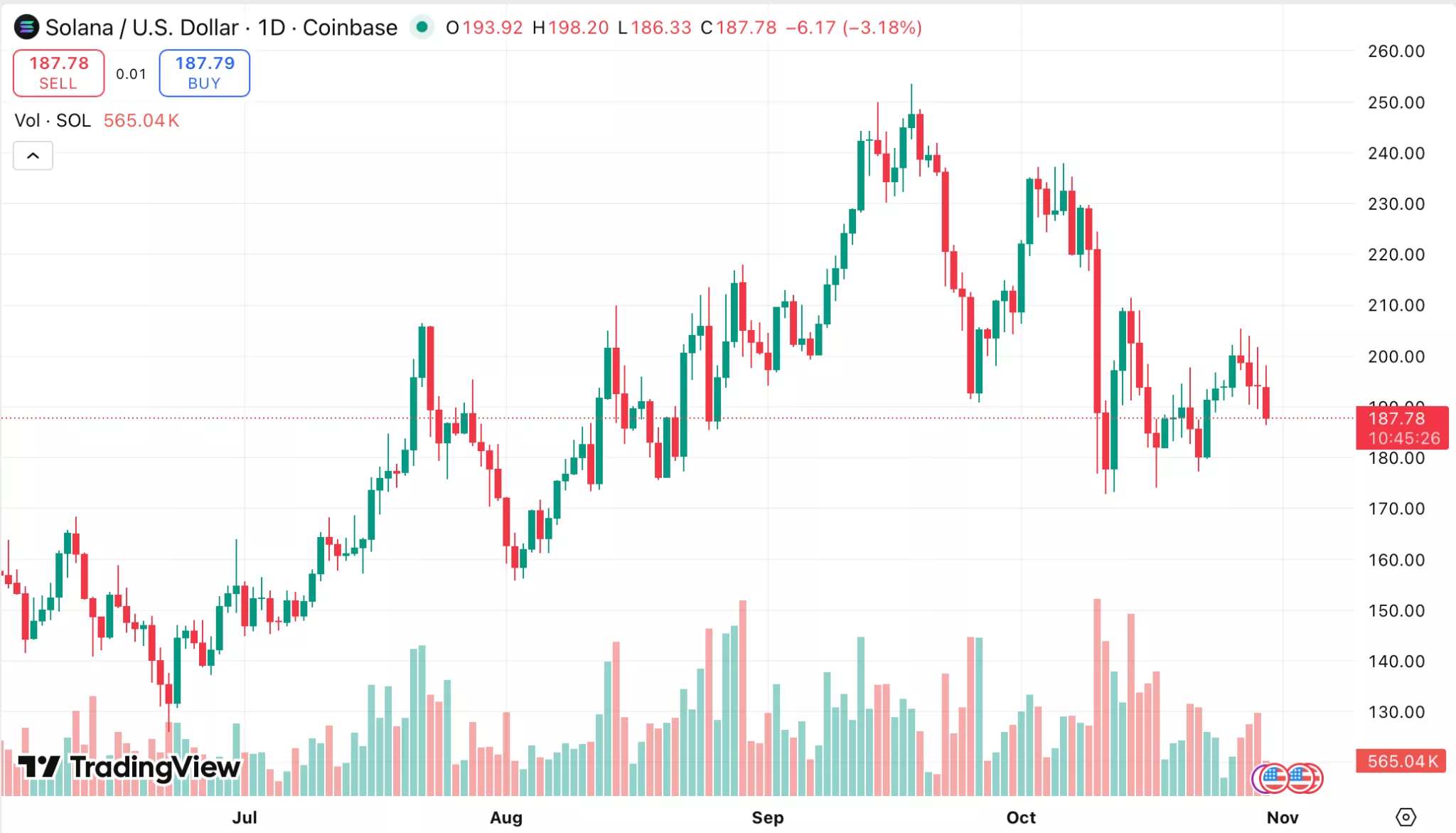Solana price prediction is back in focus as ETF inflows top $117M within two days, yet the token refuses to break past $200. What’s next?
Summary
- The first spot Solana ETFs launched on Oct. 28, attracting more than $117M in two days and setting records for 2025 ETF debuts.
- On-chain data show steady fundamentals with 3,500 transactions per second, 3.7M daily wallets, and $1B in tokenized asset transfers.
- Traders remain divided on Solana’s next move, with key support near $180 and upside targets around $260 to $300 if momentum builds.
- Algorithmic forecasts range from $220 in 2025 to over $1,000 by 2030, though analysts warn such models rarely match market reality.
ETF debut pushes SOL into mainstream
On Oct. 28, the U.S. crypto market entered a new phase as the first spot Solana ETFs went live, offering investors direct exposure to the network’s native token, SOL, through traditional financial channels.
The debut was led by Bitwise Asset Management, whose Bitwise Solana ETF (BSOL) became the first U.S. ETF to offer full spot exposure to Solana (SOL), allowing investors to access SOL’s market performance directly rather than through futures or synthetic instruments.
The fund also includes built-in staking, allowing participants to earn around 7% annual yields from network rewards. The structure replicates on-chain earnings within a regulated investment format.
A day later, on Oct. 29, Grayscale Investments followed with the launch of its own spot Solana ETF, converted from the existing Grayscale Solana Trust (GSOL).
The move marked Grayscale’s third spot crypto ETF after Bitcoin (BTC) and Ethereum (ETH), extending institutional access to Solana through a familiar regulated framework.
The trading activity following the debut showed strong initial interest. According to data, Bitwise’s BSOL ETF recorded the highest trading volume among roughly 850 ETF launches in 2025, ranking first on the New York Stock Exchange on Oct. 28.
According to Bloomberg ETF analyst Eric Balchunas, the momentum carried into the second day, with trading volume reaching $72 million. Over the first two sessions, cumulative net inflows crossed $117 million by Oct. 29.
Despite the strong institutional inflows, Solana’s market price has remained stable rather than euphoric. The token briefly touched $204 during the hours following the ETF’s launch but later settled near $191 on Oct. 30, marking a daily decline of about 6.5% in the last 24-hours.

Analysts at JPMorgan estimate that Solana ETFs could attract between $3 billion and $6 billion in the first year, depending on investor adoption trends seen with Bitcoin and Ether ETFs.
Let’s dive into the latest developments surrounding the ecosystem and how they affect the Solana price prediction in the coming days.
Solana fundamentals strengthen beneath the surface
Solana’s network metrics and on-chain economics are showing measurable progress. On Oct. 29, Solana Company (NASDAQ: HSDT) disclosed that it holds over 2.3 million SOL tokens and recorded a gross staking yield of 7.03% annualized for the month up to Oct. 27.
The same filing noted that the network continues to process over 3,500 transactions per second while hosting around 3.7 million daily active wallets, indicating consistent operational throughput and user engagement.
Institutional activity around Solana is also gaining structure. An October 2025 report by Galaxy identified eighteen active Solana-based digital asset treasury companies (DATCOs) holding about 18 million SOL, equal to roughly 3.1% of the token’s circulating supply.
Since June 2025, over $90 million in equities have been tokenized on Solana, with more than $1 billion in transfer volume recorded, showing that Solana is becoming a foundation for tokenized real-world assets and on-chain treasury management.
At the protocol level, the network is preparing for a major efficiency upgrade called Alpenglow, expected around the end of 2025 or early 2026.
In an interview, Marinade Labs CEO Michael Repetny explained that the current cost for a validator to participate in Solana’s proof-of-stake process averages about $5,000 per month, with nearly $4,000 attributed to vote fees. The Alpenglow upgrade aims to reduce these vote-related expenses substantially.
A lower cost of operation could enable more participants to run validators, improving decentralization and reducing reliance on a few high-capacity operators.
Broader validator participation tends to strengthen a blockchain’s security model and governance structure, enhancing confidence in the network’s long-term stability.
Meanwhile, innovation within the ecosystem continues on the research front. An academic preprint dated Oct. 26 outlined a “ZK coprocessor bridge” connecting Solana to the Aztec Protocol, an Ethereum Layer 2, through the Wormhole messaging framework.
The bridge would allow private execution of Solana-originated programs within the Aztec domain, pointing toward a future of enhanced interoperability and privacy-focused cross-chain computation.
Traders split on Solana’s short-term path
Market sentiment around Solana’s short-term trajectory remains mixed, as traders balance strong ETF inflows against cautious technical setups.
Prediction markets on Polymarket show that most traders expect Solana to stay below $180 through early November, with nearly 48% of total volume concentrated around that range.
Only 15% anticipate a move above $210 before Nov. 2, indicating limited confidence in an immediate rally despite the recent wave of institutional attention.
The long-term outlook on Polymarket also points to mild optimism. Traders currently assign a 22% probability that Solana will reach a new all-time high before the end of 2025, down 21% from earlier this month.
Technical analysts remain divided. MartyParty, a crypto trader known for high-frequency setups, identified a “double bottom” pattern and projected short-term targets at $252 and $258, citing a breakout from a descending triangle formation.
In contrast, independent analyst Martin Ho noted that Solana is trading near a key support zone between $180 and $190. He believes the range could serve as a base for the next upward move if it holds.
A breakout above $210 could open room toward $260 and potentially $300 over the medium term, while a drop below $180 may lead to a correction toward the $150–$170 accumulation zone.
The short-term direction therefore depends on whether institutional demand from new ETFs translates into sustained buying pressure. A clean move above $210 would show that ETF-driven liquidity is reaching spot markets, while failure to hold the $180 level could confirm that current inflows are largely speculative.
Solana price prediction for 2025 and beyond
Algorithmic forecasting platforms show a wide range of expectations for Solana’s price trajectory over the next few years, revealing how predictive models often diverge in interpreting similar data.
According to CoinCodex, Solana is expected to trade between $193.88 and $220.19 in 2025, which would imply an upside potential of about 17.6% from current levels if the upper target is achieved.
The same model projects a comparable trading range for 2026, again peaking near $220.19, indicating that CoinCodex does not expect major acceleration in the near term beyond gradual growth.
In its long-term view for 2030, CoinCodex forecasts Solana to range between $367.27 and $446.06, representing an estimated 138% gain from today’s price if the upper level is reached.
SOL price forecasts from DigitalCoinPrice present a more optimistic scenario. The platform projects Solana’s 2025 price to vary between $170.03 and $416.74, with an average near $375.95, implying a potential doubling from current levels. The 2026 forecast expands the range to $407.15–$478.27, suggesting continued upward momentum.
For 2030, DigitalCoinPrice expects prices to average around $1,016.78, with a possible high of $1,038.85, which would imply a fivefold to sixfold increase from present valuations.
These algorithmic forecasts should be viewed as speculative indicators rather than precise predictions. Models rely on historical data, statistical correlations, and volatility assumptions that rarely account for future innovations, regulatory changes, or macroeconomic shocks.
Price projections in crypto markets seldom unfold as expected, so investors should perform their own due diligence and never invest more than they can afford to lose.
Disclosure: This article does not represent investment advice. The content and materials featured on this page are for educational purposes only.



